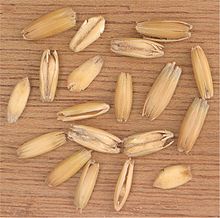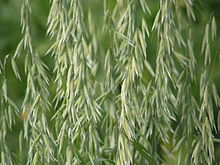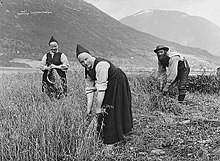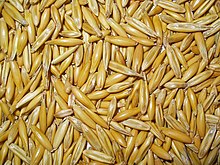Oat
| Oat | |
|---|---|

| |
| Inflorescences | |
| Scientific classification | |
| Kingdom: | Plantae |
| Clade: | Tracheophytes |
| Clade: | Angiosperms |
| Clade: | Monocots |
| Clade: | Commelinids |
| Order: | Poales |
| Family: | Poaceae |
| Subfamily: | Pooideae |
| Genus: | Avena |
| Species: | A. sativa
|
| Binomial name | |
| Avena sativa L. (1753)
| |
The oat (Avena sativa), sometimes called the common oat, is a
feed.Origin
The wild ancestor of Avena sativa and the closely related minor crop–
Cultivation
| Country | Millions of tonnes |
|---|---|
| 5.2 | |
| 4.5 | |
| 1.7 | |
| 1.5 | |
| 1.3 | |
| 1.2 | |
| 1.1 | |
| World | 26.4 |
Oats are best grown in
Production
In 2022, global production of oats was 26 million tonnes, led by Canada with 20% of the total and Russia with 17% (table).
Uses
Oats have numerous uses in foods; most commonly, they are

Historical attitudes towards oats have varied.
In Scotland, a dish was made by soaking the husks from oats for a week, so the fine, floury part of the meal remained as sediment to be strained off, boiled and eaten.[11] Oats are also widely used there as a thickener in soups, as barley or rice might be used in other countries.
Oats are also commonly used as feed for horses when extra carbohydrates and the subsequent boost in energy are required. The oat hull may be crushed ("rolled" or "crimped") for the horse to more easily digest the grain,[12] or may be fed whole. They may be given alone or as part of a blended food pellet. Cattle are also fed oats, either whole or ground into a coarse flour using a roller mill, burr mill, or hammermill. Oat forage is commonly used to feed all kinds of ruminants, as pasture, straw, hay or silage.[13]
Winter oats may be grown as an off-season
Oat straw is prized by cattle and horse producers as bedding, due to its soft, relatively dust-free, and absorbent nature. The straw can also be used for making corn dollies. Tied in a muslin bag, oat straw was used to soften bath water.
Oats are also occasionally used in several different drinks. In Britain, they are sometimes used for brewing beer.
Health
Nutrient profile
| Nutritional value per 100 g (3.5 oz) | |
|---|---|
| Energy | 1,628 kJ (389 kcal) |
66.3 g | |
| Dietary fiber | 11.6 g |
6.9 g | |
| Saturated | 1.21 g |
| Monounsaturated | 2.18 g |
| Polyunsaturated | 2.54 g |
16.9 g | |
Niacin (B3) | 6% 0.961 mg |
| Pantothenic acid (B5) | 27% 1.349 mg |
| Vitamin B6 | 7% 0.12 mg |
| Folate (B9) | 14% 56 μg |
| Minerals | Quantity %DV† |
| Calcium | 4% 54 mg |
| Iron | 28% 5 mg |
| Magnesium | 42% 177 mg |
| Manganese | 213% 4.9 mg |
| Phosphorus | 42% 523 mg |
| Potassium | 14% 429 mg |
| Sodium | 0% 2 mg |
| Zinc | 36% 4 mg |
| Other constituents | Quantity |
| β-glucans (soluble fiber) [17] | 4 g |
| †Percentages estimated using US recommendations for adults,[18] except for potassium, which is estimated based on expert recommendation from the National Academies.[19] | |
Oats contain diverse
The established property of their cholesterol-lowering effects

Soluble fiber
One type of soluble fiber, beta-glucans, has been proven to lower cholesterol.[1]
After reports of research finding that dietary oats can help lower cholesterol, the United States
Oat
Protein
Oats are the only cereal containing a
Oat protein is nearly equivalent in quality to
Celiac disease
Celiac disease (coeliac disease) is a permanent autoimmune disease triggered by certain gluten proteins. It almost always occurs in genetically predisposed people, having a prevalence of about 1% in the developed world.[25] The provocative gluten types are present in wheat, barley, rye, oat, and all their species and hybrids[2][25] and contains hundreds of proteins, with high contents of prolamins.[26]
Oat prolamins, named
Use of pure oats in a gluten-free diet offers improved nutritional value from the rich content of oat protein, vitamins, minerals, fiber, and lipids,[4][29] but remains controversial because a small proportion of people with celiac disease react to pure oats.[3][30] Some cultivars of pure oat could be a safe part of a gluten-free diet, requiring knowledge of the oat variety used in food products for a gluten-free diet.[3][4] Determining whether oat consumption is safe is critical because people with poorly controlled celiac disease may develop multiple severe health complications, including cancers.[31]
Use of pure oat products is an option, with the assessment of a health professional,[3] when the celiac person has been on a gluten-free diet for at least 6 months and all celiac symptoms have disappeared clinically.[3][32] Celiac disease may relapse in few cases with the consumption of pure oats.[33] Screening with serum antibodies for celiac disease is not sensitive enough to detect people who react to pure oats and the absence of digestive symptoms is not an accurate indicator of intestinal recovery because up to 50% of people with active celiac disease have no digestive symptoms.[33][34][35] The lifelong follow-up of celiac people who choose to consume oats may require periodic performance of intestinal biopsies.[31] The long-term effects of pure oats consumption are still unclear[31][32] and further well-designed studies identifying the cultivars used are needed before making final recommendations for a gluten-free diet.[28][29]
Agronomy


Oats are sown in the spring or early summer in colder areas, as soon as the soil can be worked. An early start is crucial to good fields, as oats go dormant in summer heat. In warmer areas, oats are sown in late summer or early fall. Oats are cold-tolerant and are unaffected by late frosts or snow.
Seeding rates
Typically, about 125 to 175 kilograms per hectare (112 to 156 pounds per acre) (between 2.75 and 3.25 US bushels (97 and 115 litres; 22.0 and 26.0 US dry gallons; 21.3 and 25.2 imperial gallons)) are sown, either
Fertilizer requirements
Oats remove substantial amounts of nitrogen from the soil, at a rate of about 1 pound per bushel. They also remove phosphorus in the form of P2O5(Phosphorus pentoxide) at the rate of 0.25 pounds per US bushel (0.0032 kg/L) pound per bushel (1 US bushel (35 L; 8.0 US dry gal; 7.8 imp gal) = 38 pounds (17 kg) at 12% moisture).[citation needed] Phosphate is thus applied at a rate of 30 to 40 kilograms per hectare (27 to 36 lb/acre). Oats remove potash (K2O) at a rate of 0.19 pounds per US bushel (0.0024 kg/L), which causes it to use 15–30 kilograms per hectare (13–27 lb/acre). A sufficient amount of nitrogen, usually 50–100 kilograms per hectare (45–89 lb/acre) of nitrogen in the form of urea or anhydrous ammonia, is particularly important for plant height, straw quality and yield. When the prior-year crop was a legume, or where ample manure is applied, nitrogen rates can be reduced somewhat.
Weed control
The vigorous growth of oats tends to choke out most weeds. A few tall
Pests and diseases
Oats are relatively free from diseases and pests. Nonetheless, it does suffer from some leaf diseases, such as
Harvesting

(Axel Lindahl/Norwegian Museum of Cultural History)
Harvest techniques are a matter of available equipment, local tradition, and priorities. Farmers seeking the highest yield from their crops time their harvest so the kernels have reached 35% moisture, or when the greenest kernels are just turning cream-colour. They then harvest by
Oats can also be left standing until completely ripe and then combined with a grain head. This causes greater field losses as the grain falls from the heads, and to harvesting losses, as the grain is threshed out by the reel. Without a draper head, there is also more damage to the straw, since it is not properly oriented as it enters the combine's throat. Overall yield loss is 10–15% compared to proper swathing.
Historical harvest methods involved cutting with a scythe or sickle, and threshing under the feet of cattle. Late 19th- and early 20th-century harvesting was performed using a binder. Oats were gathered into shocks, and then collected and run through a stationary threshing machine.
Storage
After combining, the oats are transported to the farmyard using a grain truck, semi, or
Yield and quality
The factual accuracy of parts of this article (those related to Canadian grading) may be compromised due to out-of-date information. The reason given is: the reference URL is dead, and the numbers in the article don't appear to match the new guide at https://www.grainscanada.gc.ca/en/grain-quality/official-grain-grading-guide/07-oats/primary-grade-determinants-tables.html. (September 2023) |

In the United States, No.1 oats weigh 36 pounds per US bushel (463 kg/m3); No.2 oats must weigh 33 pounds per US bushel (420 kg/m3). No.3 oats must weigh at least 30 lb/US bu (386 kg/m3). If 27 lb/US bu (348 kg/m3), they are graded as No.4, and oats under 27 lb/US bu (348 kg/m3) are graded as "light weight".
In Canada, No.1 oats weigh 42.64 lb/US bu (549 kg/m3); No.2 oats must weigh 40.18 lb/US bu (517 kg/m3); No.3 oats must weigh at least 38.54 lb/US bu (496 kg/m3) and if oats are lighter than 36.08 lb/US bu (464 kg/m3) they do not make No.4 oats and have no grade.[39]
Oats are bought and sold and yields on the basis of a bushel equal to 32 pounds (14.5 kg or 412 kg/m3) in the United States, and a bushel equal to 34 pounds (15.4 kg or 438 kg/m3) in Canada. "Bright oats" were sold on the basis of a bushel equal to 48 pounds (21.8 kg or 618 kg/m3) in the United States.
Yields range from 60 to 80 US bushels per acre (5.2–7.0 m3/ha) on marginal land, to 100 to 150 US bushels per acre (8.7–13.1 m3/ha) on high-producing land. The average production is 100 US bushels per acre (8.7 m3/ha), or 3.5 metric tons per hectare (1.4 long ton/acre; 1.6 short ton/acre). Straw yields are variable, ranging from 1–3 metric tons per hectare (0.40–1.19 long ton/acre; 0.45–1.34 short ton/acre), mainly due to available nutrients and the variety used (some are short-strawed, meant specifically for straight combining).
Genome
Avena sativa is an
Genetics and breeding
Species within Avena can
It is also possible to do introgression of traits in oats from very wide
The addition lines with alien chromosomes can be used as a source for novel traits in oats, for example, research on oat-maize-addition lines has been used to map genes involved in
A 2013 study applied
Processing
This section needs additional citations for verification. (October 2013) |

Cleaning and sizing
Upon delivery to the milling plant, chaff, rocks, metal, oversized materials and foreign grains are removed from the oats. As different sized oats de-hull at differing velocities, once the raw oats have been removed of impurities, they are then separated by width and length into different classifications before de-hulling.
Dehulling
Centrifugal acceleration is used to separate the outer hull from the inner oat groat. Oats are fed by gravity onto the centre of a horizontally spinning impeller, which accelerates them towards an outer mill ring. Groats and hulls are separated on impact. The lighter oat hulls are then aspirated away, while the denser oat groats are taken to the next step of processing. Oat hulls can be used as feed or as a biomass fuel and are often used within the oat processing line to power solid fuel boilers for steam and power generation. Excess oat hulls are generally pelletised before being provided as feed.
Kilning
The unsized oat groats pass through a heat and moisture treatment to balance moisture for optimal storage conditions and to deactivate self catalysing enzyme activity. Oat groats are high in fat (lipids) and once removed from their protective hulls and exposed to air, enzymatic (
Sizing of groats
Some whole oat groats break during the de-hulling process so additional processing of the groats is required. Groats are sized again and separated by length and width using shaker screens and indent cylinders until uniform product streams are generated. Modern oat milling technologies also sort impurities by colour with colour sorting machines or more traditionally, on specific gravity with paddy tables or gravity table separators. A final grade of whole oat groats should have minimal oat hulls, other seeds or broken groats.
When the whole oat groats are to be flaked for use in porridge, the whole groats are passed through a groat cutter machine to create uniform pieces of cut groats for quick or instant style porridge whereas traditional style porridge is flaked from whole groats.
The small percentage of broken groats generated throughout the de-hulling process are also utilised in various other products or even in flaking for porridge.
Final processing
Three methods are used to make the finished product:
Flaking
This process uses two smooth cylinders rotating at a controlled distance, before which the cut groats are conditioned and then passed through the cylinders for flaking. Conditioning of the groats for flaking ensures production of stable and consistent flakes with minimal crumbling and is done by adding moisture and heat to the groats with sufficient retention time prior to flaking. Oat flake thickness is a key control point dependant of the type of oat flakes to be produced which typically range from around half a millimetre for quick or instant style porridge and up to around 1mm for traditional style porridge. After flaking, the oats are then dried to a sufficient moisture for storage and transport.
Oat bran milling
This process takes the oat groats through several roll stands to flatten and separate the bran from the flour (endosperm). The two separate products (flour and bran) get sifted through a gyrating sifter screen to further separate them. The final products are oat bran and debranned oat flour.
Whole flour milling
This process takes oat groats straight to a grinding unit (stone or hammer mill) and then over sifter screens to separate the coarse flour and final whole oat flour. The coarser flour is sent back to the grinding unit until it is ground fine enough to be whole oat flour.[citation needed]
Preparation at home
Oat flour can be ground for small scale use by pulsing rolled oats or old-fashioned (not quick) oats in a food processor or spice mill.[55]
Oats futures

Oats futures are traded on the Chicago Board of Trade and have delivery dates in March (H), May (K), July (N), September (U) and December (Z).[citation needed]
See also
Oat products and derivatives
References
- ^ PMID 25411276.
- ^ S2CID 6493455.
Similar proteins to the gliadin found in wheat exist as secalin in rye, hordein in barley, and avenins in oats and are collectively referred to as "gluten." Derivatives of these grains such as triticale and malt and other ancient wheat varieties such as spelt and kamut also contain gluten. The gluten found in all of these grains has been identified as the component capable of triggering the immune-mediated disorder, coeliac disease.

- ^ PMID 27446825.
- ^ PMID 26557006.
It is necessary to consider that oats include many varieties, containing various amino acid sequences and showing different immunoreactivities associated with toxic prolamins. As a result, several studies have shown that the immunogenicity of oats varies depending on the cultivar consumed. Thus, it is essential to thoroughly study the variety of oats used in a food ingredient before including it in a gluten-free diet.
- PMID 21294744.
- ^ S2CID 8521495.
- S2CID 8521495.
- ^ "FAOSTAT". www.fao.org. Retrieved 28 February 2024.
- ^ Hitchens, A (6 August 2018). "Hey, Where's my oat milk?". The New Yorker. Retrieved 10 December 2018.
- ^ Elaine Watson (25 September 2020). "Oatmilk edges past soymilk for #2 slot in US plant-based milk retail market". FoodNavigator-USA.com, William Reed Business Media, Ltd. Retrieved 20 December 2020.
- ISBN 978-0-85976-067-6.
- ^ "Oats: The Perfect Horse Feed?". Kentucky Equine Research. 2003-12-29. Retrieved 2023-06-20.
- CIRAD, Association Française de Zootechnie and FAO. Retrieved 2023-03-27.
- ^ "Grazing of Oat Pastures". eXtension. 2008-02-11. Archived from the original on 2017-11-23. Retrieved 2013-03-27.
- ^ The Compleat Housewife, p. 169, Eliza Smith, 1739
- ISBN 0-313-31962-6
- ^ "Oat and barley ß-glucans" (PDF). Agriculture and Agri-Food Canada, Government of Canada. 1 August 2008. Archived (PDF) from the original on 2018-05-13. Retrieved 27 July 2019.
- ^ United States Food and Drug Administration (2024). "Daily Value on the Nutrition and Supplement Facts Labels". Retrieved 2024-03-28.
- )
- ^ "Nutrition for everyone: carbohydrates". Centers for Disease Control and Prevention, US Department of Health and Human Services. 2014. Retrieved 8 December 2014.
- ^ "LDL Cholesterol and Oatmeal". WebMD. 2 February 2009.
- ^ FDA). 1 April 2015. Retrieved 10 November 2015.
- Plant Cell. Archived(PDF) from the original on 2015-09-24. Retrieved 2013-03-27.
- ISBN 978-0-8493-2763-6.
- ^ PMID 25789300.
- PMID 24481131.
- ^ PMID 24253052.
- ^ PMID 27446824.
- ^ (PDF) from the original on 2017-10-07.
- PMID 25922672.
- ^ PMID 17068278.
- ^ PMID 19595389.
- ^ PMID 17948135.
- PMID 28067823.
- S2CID 46285202.
Intuitively, resolution of symptoms, normalization of histology, and normalization of coeliac antibodies should define response to treatment. But asymptomatic CD may occur in up to 50% of affected individuals,5 symptoms correlate poorly with mucosal pathology,6 and even with excellent dietary adherence, histology and coeliac antibodies can take several years to normalize.7

- ^
Pratap, Aditya; Kumar, Jitendra (2014). Alien Gene Transfer in Crop Plants. Vol. 2 : Achievements and impacts. ISBN 978-1-4614-9572-7.
- PMID 28846186.
- ^ "Oat crown rust". Cereal Disease Laboratory. United States Department of Agriculture| Agricultural Research Service. 18 April 2008. Retrieved 15 November 2015.
- ^ "Oats – Chapter 7 – Official Grain Grading Guide – 5 / 7". Grainscanada.gc.ca. 2012-07-27. Retrieved 2013-03-27.
- ^ S2CID 254152395.
- ORCID 0000-0002-9145-5371.
- ORCID 0000-0003-1410-5631.
- S2CID 211554462.
- S2CID 22267641.
- S2CID 248890897.
- S2CID 229342158.
- S2CID 208225185.
- S2CID 249381794.
- ORCID 0000-0003-0036-3330.
- S2CID 22852580.
- S2CID 23707249.
- PMID 29952140.
- S2CID 254499298.
- S2CID 18581328.
- ISBN 978-1-4019-3132-2, page 98.
